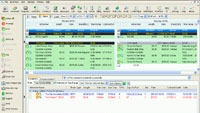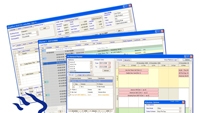Taking a hard look at operations

There’s an old business adage that when times get tough, the smartest businesses spend money to shore up their infrastructure and examine what they are doing right or wrong in delivering goods to the marketplace.
That also appears to be the case in the broadcast industry, where large media companies have been looking hard at how they can make their technology and resources more productive. In addition to staff reductions and centralized operations, they’re doing this by investing in software-based administration platforms that help identify, allocate and execute projects in a way that makes the most financial sense.
In previous years media companies like ABC, CBS, CNN, Fox, NBC and the larger independent station groups would have hired their own IT professionals to write special code and develop custom applications that help figure out the best way to move content around a facility (or group of facilities) and schedule staff to make their operations more productive. This has become prohibitively expensive for almost everyone these days.
Instead, media organizations are turning to vendors that market a variety of sophisticated business management applications to handle the multifaceted job of “asset allocation” and resource management. The software programs accomplish this through various machine control methods and task-driven process analysis, as well as by leveraging metadata that describes how the media has been recorded, when it can be used, and who has access to it. This last part extends to consumer use and protects copyrighted material from unwanted use. It also helps broadcasters and content distributors verify when programs and commercial spots aired — thereby generating the most revenue.
Online access
Virtually all of these applications can be accessed via a Web browser from any desktop or laptop, anywhere in the world. This results in a powerful way for operations managers to keep a close watch on how a company is functioning and where cost efficiencies can be realized. They also enable users to quickly and cost-effectively launch new services, when they make sense, which can lead to new revenue streams.
The Discovery Channel is in the process of digitizing archived content stored on 1.3 million videotapes. This is a massive undertaking that requires large amounts of automation, file organization and sophisticated software applications working in sync with dozens of transcoders. The goal is clear. Once the content is digitized, it can be easily accessed and repurposed. Using metadata managed by a series of applications from TransMedia Dynamics called Mediaflex, the network can easily organize the physical media and its related digital files, while making the essence of those files available to editors and producers who use them for future projects.
“In these challenging times, media companies are looking hard at their businesses and trying to find new ways to save cost while still getting the job done that they need to,” said Tony Taylor, chairman/CEO of TransMedia Dynamics. “We’re finding that our business solutions are more important to the company’s bottom line than some of the new hardware technology these companies are deploying right now.”
The professional video industry's #1 source for news, trends and product and tech information. Sign up below.
Focus on what broadcasters do best
Pilat Media is another supplier of software solutions for managing media businesses. Many large corporations are using its Integrated Broadcast Management System (IBMS) and MediaPro software platforms to help improve business performance by streamlining the handling of programming, advertising sales and overall media operations.
The CBS Network, for example, is using the solution at its master control facility in New York City, according to John Larrabee, vice president of North American sales for Pilat. He said that the network saved millions of dollars by choosing Pilat’s products instead of writing its own code.
“I think that at the end of the day broadcasters realize that they are not in the software writing business and that they need to stay focused on their core business of content creation and delivery,” said Larrabee. “Networks can’t afford to waste time and money when all they really want to do is make their operations more efficient.”

Like all of the vendors in the category, Pilat Media's IBMS and MediaPro products can be deployed in modules for specific business and creative units, or as an enterprise-wide integrated system. That’s the beauty of a software platform — it can be integrated into an existing facility in stages, so as not to disrupt the ongoing operations.
Harris markets its OSi-Traffic and ADC automation software suites, which support the entire broadcast operation, from proposals and sales through scheduling and playout. They also accommodate third-party products and extend licensing capabilities that work together to help facilities or station groups manage and grow their business. The ease at which these software platforms can be seamlessly integrated into existing infrastructures is critical to success.
The OSi-Traffic platform automates data exchange and workflow processes while supporting multichannel broadcasts in HD and SD. The various applications also help prepare and distribute content to alternative delivery platforms, including VOD, IPTV and mobile video. This is something virtually every media company is pursuing.
Getting creative to improve productivity
In these tough times broadcasters’ goals have shifted from making profit (although that’s always the end game) to finding creative ways to become more efficient with fewer resources. ScheduALL, which markets several types of workflow technology and resource (facilities and people) management solutions, is helping clients such as CBS, Fox News Network, and Turner Studios make their existing resources more productive. These media companies are not adding additional staff yet they continue to add new channels and services.
ScheduALL’s engineers have developed an Enterprise Resource Management (ERM) solution that facilitates resource sharing within a single plant or across facilities that are geographically dispersed. It allows operations managers to keep a tight grip on making the most of what’s available to them from their desktop on a daily basis. Resources can be shared on a one-to-one basis within dedicated business units and also be made available to the entire corporation via a secure online network.
The age-old term “media asset management” continues to be an important part of streamlined operations management, deployed for the sake of cost savings. Grass Valley has developed a solution called ContentShare2 that targets the full gamut of assets and content with a wide array of software features that support any type of broadcast operation.
It allows a user to link virtually any essence type to an asset and manage it throughout the system. This lets the software handle multiple resolutions and formats of the same content, keep multiple audio tracks intact and simultaneously orchestrate a variety of other functions. Documents, spreadsheets or specific information can also be attached to any asset or group of assets.
Eric DuFossé, director of marketing systems solutions at Grass Valley, said that for broadcasters to streamline their operations cost-effectively, “the key is to administrate the entire operation, not the specific task.”
Getting more from less is a goal everyone is trying to achieve.
